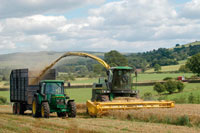Wholecrop a valuable feed option

Livestock producers may be facing forage shortages following a prolonged winter, late spring and a lack of rain, but there are options and time yet to make sure winter requirements are covered, according to Biotal forage products manager Nick Berni.
“Clamps are probably emptier than previous years so it’s important in the next couple of weeks to measure up the clamp and take stock of forage levels in order to work out winter requirements,” he says.
Reports from across the country indicate forage, weather silage or hay, will be lacking. In the south west second-cut silage is average, with quality good and yields average, says contractor Alan Butt, Somerset. “Ryegrasses have faired well, but when it comes to permanent pastures used for hay, a combination of a cold spring and a lack of rain mean there is not much of it, although quality is good.”
However, in the north west, second-cut silage hasn’t even begun, says contractor John Horsley, Cumbria. “First-cut silage isn’t even finished in some areas. Although quality is there, the quantity isn’t which means many will face shortages. Hay on the other hand is some of the best produced in the last five years.”
But, for those farmers facing shortages there are options to make sure winter requirements are covered, adds Mr Berni.
“There’s still time for producers to source a standing cereal crop and because it doesn’t look like this year will be such a good year for cereal prices, producers wishing to purchase whole-crop may be able to secure a cost-effective option.”
And because whole-crop is a high dry matter, high energy, starch-based feed, it is a favourable feed option particularly with limited grass silage around and quality and quantity variable, says Peter Lord, who manages 375 cows at Hartpury College for Velcourt.
“From a feeding point of view it is an excellent forage to keep the rumen well balanced and functioning and we have seen the result of this through an increase in milk yield.”
Whole-crop’s flexibility means it can also be fed to all livestock species, adds Mr Berni. “It can be fed as a TMR or alone. It is an excellent forage for dairy cows, beef cattle and even sheep. Fermented whole-crop would ideally be stored in a clamp or ag-bag, but there are a number of producers who bale and wrap it.”
Whole-crop could also fill the gap before maize is available, adds Mr Berni. “It is a stop gap until maize is available, as it could be available to feed by the end of August/early September. It is also a great buffer feed when cows first go on to spring grass, it is everything grazed grass isn’t,” he says.
The most popular whole-crop is winter wheat, but there has been a resurgence in triticale, adds Mr Berni. “Particularly with organic producers triticale is making a comeback because it is more disease resistant and can out-compete weeds.”
And at a cost of £25/t to grow and harvest whole-crop winter wheat and £20/t to grow and harvest whole-crop triticale, it is a cost-effective feed option too, says Mr Berni.
